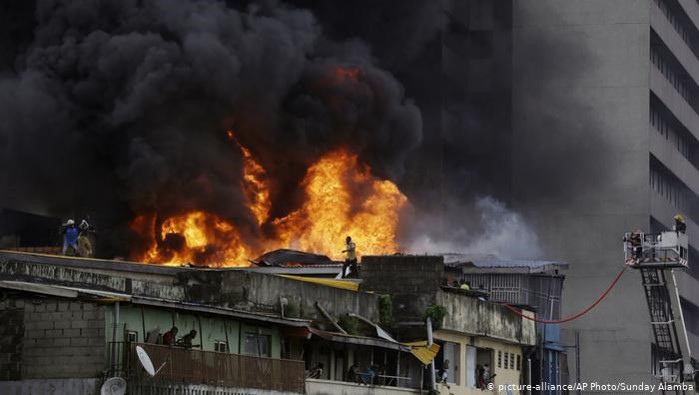By Lasisi Adedoyin K.S
As the first-due engine arrives, the crew leader can see Mr & Mrs. Ologundudu waiting anxiously outside their house. Heavy smoke is venting from a first-floor window. Mrs. Ologundudu asking the crew do you have water? is your engine working? Without excitation, the engine operator positions the apparatus, the crew begin to stretch a line and the crew leader talks with Mrs. Ologundudu, who tells her we are professionals. She comment “you speak good English. Jokingly he said I am a graduate of Obafemi Awolowo University. With huge smiles and excitement she shouted great Ife. Within 3 min, the crew leader completes his 360-degree assessment, the total operation took just 25 min from the time the first-due truck arrives, within a period of 30 minutes, Mr. and Mrs. Ologundudu who are shouting on top of their voices had stated raising praises on the fire crew, neighbors bring drinks, the estate management offering cash reward and everyone talking about how effective the operation was.
This is a common scenario in fire situations across the State. A resident has a fire or emergency situation and calls the emergency line (mostly many do know the direct line to the nearest fire station) call intake information is gathered, the crews are dispatched, and firefighters turn out and arrive on scene to mitigate the situation. But hidden among these everyday actions are hundreds of data points, important clues to understanding whether the fire services has enough resources to address emergencies in the community.
On the 14th December, 2023) like most days, Nigerians shows the educated illiterate syndrome that has always contribute to low responses time to fire emergency in Lagos State. On the highly busy Lekki-Epe expressway with vehicles ranging from highly luxury Bentley to the common commercial korope, its took the fire truck and average of 3-5 min to move from lekki Phase one to Ikate. The National Fire Protection Association (NFPA Standard 1710) establishes an 80 second “turnout time” and 240 second “travel time” (together, 320 seconds or 5 minutes and 20 seconds “response time”). However, fire response time differs from city to city depending on geographical settings, density and other factors.
The above situation is becoming a daily occurrence in most part of Lagos and if urgent action is not taken emergency response time which should be the easier part of emergency procedure may become has become the bottle neck to it. Saving peoples lives is still the heart of firefighting. The primary purpose of the fire and rescue service is the prompt and efficient mobilization of firefighters in response to a fire or other related incident, in order to save lives and protect property. This is a key aspect of public safety that must be understand by every citizen. Over the years, I have come to understand that the efficiency of our fire service is linked to the ability of the officers and the response time. However, opposite is the case.
In my over ten years of lecturing and researching on fire incident it has become evident that we has a people are making fire service work more difficult and more challenging for the fire men. Form lack of enforcement of fire regulation, to poor attention to fire issues. The fire service is now been reduce to the bottom of safety hierarchy. Early this year, a popular comedian house was involved in fire incident in one of the gated community in Lekki (I don’t call them estate because the don’t meet the standard of an estate). The fire service trucks could not enter the gated community easily because of poorly designed road infrastructure . Regrettable few months before the incident, fire officers were denied access to some estate in the area when they wish serve notice of inspection.
Today, rapid urbanization and population growth are driving the construction of new buildings, with global building stocks expected to double in the next 15 to 20 years. While such trends will represent significant development advances and offer economic growth opportunities, concern remains regarding the resilience and safety of new and aging building stocks that will support the living environment and lifestyle of people. Driving around Lagos today and seeing how building and estates are constructed without proper regards to fire safety. It points me to the challenges that will be face by the fire service in the next 5 to 10 years. Look around you now, the windows and doors are becoming smaller, the roads are becoming smaller and narrower, estate and communities are designed without following standards regulations for fire safety.
For example, the faster the fire service can respond and set up, the sooner they can begin to mitigate an incident. This should translate into increased safety for firefighters and occupants as well as decreased property loss and indirect business loss. The time taken to set up and sustain firefighting operations can be considerable for high-rises and other complex buildings. This time can be extended when the fire location is not obvious or is remote from the arrival location. Let look at some of the condition that contributes to effective fire prevention and see if our estate and communities meet up with the requirements.
Many buildings are located on public streets that provide good access to at least one side in the case of an emergency, today cars are parked on most street. Fire officer have to practically start to beg residents to move their cars for fire trucks to access some building. This is more embarrassing in newly constructed estates especially in lekki and it’s environ. The entrance gates are too small the roads are not just there. In addition, another common observation is the road dimensions. The dimensions for roads and fire lanes that lead to a building must accommodate all apparatus that will use them. Spaces wider than the apparatus itself may be needed for several reasons. One is to enable apparatus to pass each other if necessary to facilitate developing and expanding operations. Near hydrants or other water sources, engine companies may need a wider area to facilitate hose connections, allow other fire service vehicles to pass, or permit water tenders to position alongside pumpers. Also proximity is very important when designing estate and gated community. It is important for fire apparatus to have close access to buildings to facilitate the stretching of hose lines, the use of a master stream device, or the placement of portable ladders. Long hose stretches can delay the time it takes to contain or extinguish a fire. Similarly, carrying ladders a long distance can delay access or rescue.
Additional in designing gated community or estate for the use of fire service, the following must be considered; turning radius: the minimum turning radius (inside and outside edges) for the most restrictive fire apparatus should be considered. Dead-end fire lanes or roads that exceed a certain length should have a means for fire apparatus to turn around. Turnarounds save considerable time when a fire apparatus. Traffic Calming Features such as Speed bumps/humps/tables, narrow road widths, curvy arrangements, and islands are traffic calming features used to control vehicular traffic speed most of such measures that slow traffic also hinder fire apparatus access, delaying their arrival to a fire scene.
Water is used to suppress most fires, so an adequate water supply is crucial to fire service operations. The supply must deliver an adequate amount of water through a distribution system to the locations needed. The system can serve manual firefighting (typically through fire hydrants), fire standpipe systems, fire sprinkler systems, other water-based suppression systems, and non-fire needs (industrial, commercial, domestic, etc.). It is sadden to known that most estate and communities are constructed without plan for fire hydrants. It’s not recommended that fire engines has to travel distance to get water for replenishing.
For us to have a good firefighting system we need to put in place a well structure firefighting system and developed a firefighting strategy. In a bustling metropolis like Lagos, where the population is rapidly growing, the need for a robust fire safety management strategy becomes even more imperative. A fire safety management strategy encompasses a range of measures designed to prevent, detect, and respond to fires. It involves conducting risk assessments to identify fire hazards, implementing preventive measures like fire alarms and extinguishers, establishing emergency evacuation plans, and ensuring adequate training for individuals and communities. Lagosians play a vital role in fire safety management. As individuals living and working in Lagos, it is our responsibility to be aware of potential fire hazards and take necessary precautions to prevent fires. This includes adhering to safety guidelines, practicing good housekeeping, and promptly reporting any fire hazards or incidents to the appropriate authorities.
Furthermore, raising awareness among Lagosians about fire safety is crucial. This can be achieved through public education campaigns, workshops, and community engagement programs to ensure that everyone understands the importance of fire safety and their role in preventing and responding to fire emergencies. Collaboration between Lagosians and authorities, including fire services, is essential for effective fire safety management. Lagosians should actively engage with the authorities by reporting potential fire hazards, participating in fire drills, and following safety instructions during emergencies. By working hand-in-hand with the fire services, Lagosian can contribute to faster response times and more efficient handling of fire incidents. This collaboration also involves being knowledgeable about emergency contact numbers, establishing communication channels with local fire stations, and supporting efforts to improve fire infrastructure and resources in the city.
In conclusion, the effective management of fire incidents in Lagos requires a collective effort and a comprehensive strategy. Lagosians play a vital role in fire safety management, both in terms of their responsibility and awareness. To ensure a safer Lagos, fire safety management must be a priority. By implementing advanced technology and systems, providing training for firefighters, building awareness among Lagosians, and strengthening emergency response systems and infrastructure, we can enhance fire safety in the city. However, this requires the collaboration and active participation of all Lagosians. Together, we can make a significant difference in ensuring a fire-safe environment for everyone. So, let’s blaze a trail towards a safer Lagos! Let be safe it’s dry, the dry season is here.
Environment and Safety Expert, Coordinator of Eko Enviro Talk TV





